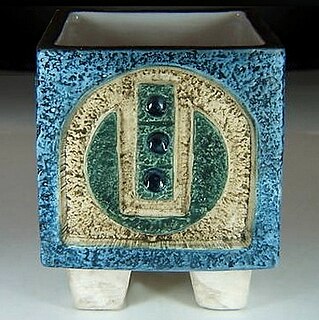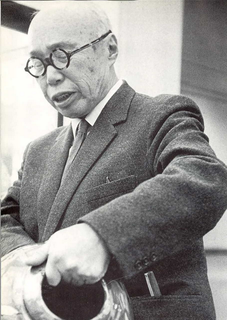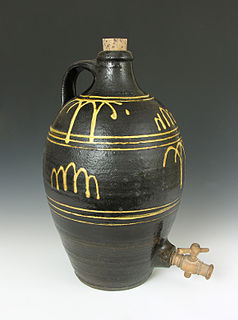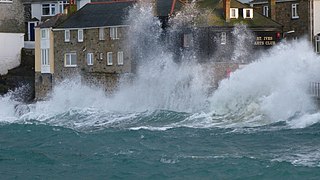
St Ives is a seaside town, civil parish and port in Cornwall, England. The town lies north of Penzance and west of Camborne on the coast of the Celtic Sea. In former times it was commercially dependent on fishing. The decline in fishing, however, caused a shift in commercial emphasis, and the town is now primarily a popular seaside resort, notably achieving the title of Best UK Seaside Town from the British Travel Awards in both 2010 and 2011. St Ives was incorporated by Royal Charter in 1639. St Ives has become renowned for its number of artists. It was named best seaside town of 2007 by The Guardian newspaper.

Bernard Howell Leach, was a British studio potter and art teacher. He is regarded as the "Father of British studio pottery".

Mashiko is a town located in Tochigi Prefecture, Japan. As of 1 August 2020, the town had an estimated population of 21,841 in 7914 households, and a population density of 240 persons per km². The total area of the town is 89.40 square kilometres (34.52 sq mi). Mashiko is known for its pottery, called Mashiko ware (益子焼).

Troika was an art pottery that operated in Cornwall from 1962 to 1983. It was founded by three people, Leslie Illsley, Jan Thompson and Benny Sirota who took over the Powell and Wells Pottery at Wheal Dream, where Sirota had previously worked as a decorator and driver. The name is from the Russian тройка, meaning "a set of three", or triumvirate.
Leonard Ramsay Castle was a New Zealand potter.

Shōji Hamada was a Japanese potter. He had a significant influence on studio pottery of the twentieth century, and a major figure of the mingei (folk-art) movement, establishing the town of Mashiko as a world-renowned pottery centre. In 1955 he was designated a "Living National Treasure".

Michael Ambrose Cardew (1901–1983), was an English studio potter who worked in West Africa for twenty years.

David Andrew Leach OBE was an English studio potter and the elder son of Bernard Leach and Muriel Hoyle Leach, Bernard's first wife.

KatherineHarriot Duncombe Pleydell-Bouverie was a pioneer in modern English Studio pottery.
William "Bill" Marshall was an English studio potter, known for his Japan-influenced style.

Gwyn Hanssen Pigott OAM (1935–2013) was an Australian ceramic artist. She was recognized as one of Australia’s most significant contemporary artists. By the time she died she was regarded as "one of the world's greatest contemporary potters". She worked in Australia, England, Europe, the USA, New Zealand, Japan and Korea. In a career spanning nearly 60 years, influences from her apprenticeships to English potters were still apparent in her later work. But in the 1980s she turned away from production pottery to making porcelain still-life groups largely influenced by the Italian painter Giorgio Morandi.

Winchcombe Pottery, near Winchcombe in Tewkesbury Borough, North Gloucestershire, is an English craft pottery founded in 1926.

The St Ives School refers to a group of artists living and working in the Cornish town of St Ives. The term is often used to refer to the 20th century groups which sprung up after the First World War around such artists as Borlase Smart, however there was considerable artistic activity there from the late 19th Century onwards.
Janet Darnell Leach, was an American studio potter working in later life at the Leach Pottery in St Ives, Cornwall in England. After studying pottery at Black Mountain, North Carolina under Shoji Hamada, a visiting artisan, she traveled to Japan to work with him. She studied with him for two years and always considered him to be her principal mentor. She was the first foreign woman to study pottery in Japan and only the second westerner.
Harry Clemens Davis was a Welsh-born New Zealand potter, and husband of May Davis.

Ray Finch MBE, formally Alfred Raymond Finch, was a respected English studio potter. who worked at Winchcombe Pottery for a period spanning seventy five years.

William Alfred Ismay or Bill Ismay was a librarian, writer and collector in Wakefield, West Yorkshire known for his significant collection of post-war studio pottery. The collection called the W.A. Ismay Collection was bequeathed to the Yorkshire Museum and is one of the world's largest collections of 20th-century studio pottery. It includes work by Bernard Leach, Hans Coper, Shoji Hamada, Takeshi Yasuda, David Leach Dan Arbeid and Lucie Rie.
Jack Doherty is a Northern Irish studio potter and author. He is perhaps best known for his vessels made of soda-fired porcelain. He has been featured in a number of books, and his work has been exhibited widely in both Europe and North America. Articles of his have appeared in various pottery journals and he has been Chair of the Craft Potters Association.

Asahi ware is a type of Japanese pottery traditionally from Uji, Kyoto.
John Leach was a studio potter, the eldest son of David Leach and the eldest grandson of Bernard Leach. Born in St Ives in 1939, he studied under his grandfather and father at St Ives and under Ray Finch at Winchcombe. Leach left school in 1957 and worked with his father at Lowerdown Pottery Bovey Tracey, Devon and from 1961 to 1962 he was an apprentice at the Leach Pottery St Ives. He founded Mulcheney Pottery on the Somerset Levels in 1964, and developed a range of pottery using local clay and wood to fuel the kiln.















